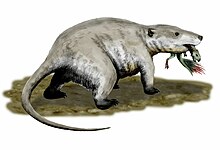爬兽属
| 爬兽属 化石时期:早白垩纪
| |
|---|---|

| |
| 巨爬兽(R. giganticus)模式标本,展示于中国古动物馆 | |
| 科学分类 | |
| 界: | 动物界 Animalia |
| 门: | 脊索动物门 Chordata |
| 演化支: | 哺乳型类 Mammaliaformes |
| 纲: | 哺乳纲 Mammalia |
| 目: | †戈壁尖齿兽目 Gobiconodonta |
| 科: | †戈壁尖齿兽科 Gobiconodontidae |
| 属: | †爬兽属 Repenomamus Li et al., 2000 |
| 模式种 | |
| †硕爬兽 Repenomamus robustus Li et al., 2001[1]
| |
| 种 | |
| |
爬兽属(学名:Repenomamus)为哺乳类戈壁尖齿兽科下已灭绝的一属,体型约与负鼠或獾相当[2],包括两个物种:硕爬兽(R. robustus)与巨爬兽(R. giganticus)。两种爬兽均发现于白垩纪早期的中国,约于125-123.2百万年前。其中硕爬兽是少数中生代哺乳类中[6]具有明确证据显示以脊椎动物为食的物种,包括恐龙,虽然仍无法确定硕爬兽是狩猎恐龙活体或是仅以恐龙的死尸为食。而巨爬兽则是目前已知中生代体型最大的哺乳动物。
发现史与分类学
[编辑]
爬兽的化石发现于中国辽宁省义县组化石库,地层年代约为125-123.2百万年前的早白垩纪时期。
爬兽属于真三尖齿兽目,是十分早期的哺乳动物,没有现存近亲。本属中的硕爬兽于2000年由王元青与李传夔等人发现并发表命名;巨爬兽则是于2005年由胡耀明、孟津、王元青、李传夔等人发现并发表命名。目前这两种为爬兽科(Repenomamidae)下唯二的物种,不过也有研究将爬兽属置于戈壁尖齿兽科下,然而这分类形势仍然存在着争议。
描述
[编辑]
完整的骨架化石显示爬兽为目前已知体型最大的中生代哺乳动物之一(与Schowalteria、Oxlestes、库都克掠兽及Bubodens体型相当[7][8],而十字齿兽可能具有较爬兽巨大的体型[9])。成年硕爬兽的体型相当于现存的北美负鼠,估计体重约为4—6千克(8.8—13磅),而成年巨爬兽的体型则较硕爬兽大上50%,体长可达1米(3英尺3英寸),体重约为12—14千克(26—31磅)。事实上,爬兽属的体型甚至超越了数种分布区域重叠的小型驰龙科恐龙,例如纤细盗龙[10]。从肩膀与腿骨的构造看来,爬兽与其他小至中型兽亚纲哺乳动物一样四肢为两侧延展,且为跖行。和兽亚纲哺乳动物较不同的是,爬兽具有较延长的身体及较为粗短的四肢。
爬兽属的齿列最初被认为是3.1.2.42.1.2.5,然而之后的研究认为其应该是 3.1.1.52.1.2.5[11]。
古生物学
[编辑]
从爬兽属的牙齿与下颚形式,与化石胃部位置发现到的鹦鹉嘴龙幼体破碎遗骸,显示包括爬兽属在内的部分中生代哺乳动物物种是以包括恐龙在内的脊椎动物为食的肉食性动物[10]。在这之前,也曾发现具有三角齿兽咬痕的原鸟形龙脑壳化石[12]。真三尖齿兽目物种普遍具有肉食性的倾向,体型近似的物种如戈壁尖齿兽、Jugulator与三尖齿兽[13]也被认为可能以大型猎物为食,甚至有发现过腐食行为的证据[14]。
和其他非胎盘动物哺乳动物一样,爬兽属具有外耻骨,这代表牠们可能像单孔目一样产卵或是像有袋类那样产下未发展完全的幼体[10]。
参见
[编辑]参考文献
[编辑]- ^ Li; et al. A new family of primitive mammal from the Mesozoic of western Liaoning, China. Chinese Science Bulletin. 2001, 46 (9): 782–785. Bibcode:2001ChSBu..46..782L. S2CID 129025369. doi:10.1007/bf03187223.
- ^ Marisol Montellano, James A. Hopson, James M. Clark. Late Early Jurassic Mammaliaforms from Huizachal Canyon, Tamaulipas, México. Journal of Vertebrate Paleontology. 2008, 28 (4): 1130–1143. S2CID 128782275. doi:10.1671/0272-4634-28.4.1130.
- ^ Wilson Gregory P, Riedel Jeremy A. New Specimen Reveals Delta Theroidan Affinities of the North American Late Cretaceous Mammal Nanocuris. Journal of Vertebrate Paleontology. 2010, 30 (3): 872–884. S2CID 53524747. doi:10.1080/02724631003762948.
- ^ Christian DE MUIZON, Brigitte LANGE-BADRÉ. Carnivorous dental adaptations in tribosphenic mammals and phylogenetic reconstruction. Lethaia. 2007, 30 (4): 353–366. doi:10.1111/j.1502-3931.1997.tb00481.x.
- ^ Zofia Kielan-Jaworowska, Richard L. Cifelli, Zhe-Xi Luo. Chapter 12: Metatherians. Mammals from the Age of Dinosaurs: origins, evolution, and structure. New York: Columbia University Press. 2004: 425–262. ISBN 978-0-231-11918-4.
- ^ 其他后兽下纲下的真三尖齿兽目与三角齿兽总科物种也有特化为肉食性的倾向[3][4][5]
- ^ Fox R. C., Naylor B. G. A Late Cretaceous taeniodont (Eutheria, Mammalia) from Alberta, Canada. Neues Jahrbuch für Geologie und Paläontologie. 2003, 229 (3): 393–420. doi:10.1127/njgpa/229/2003/393.
- ^ Wilson R. W. Late Cretaceous (Fox Hills) multituberculates from the Red Owl local fauna of western South Dakota. Dakoterra. 1987, 3: 118–122.
- ^ Clemens et al., 2003
- ^ 10.0 10.1 10.2 Hu; et al. Large Mesozoic mammals fed on young dinosaurs. Nature. 2005, 433 (7022): 149–152. Bibcode:2005Natur.433..149H. PMID 15650737. S2CID 2306428. doi:10.1038/nature03102.
- ^ Alexey Lopatin, Alexander Averianov, Gobiconodon (Mammalia) from the Early Cretaceous of Mongolia and Revision of Gobiconodontidae, First online: 12 July 2014
- ^ Elzanowski, A.; Wellnhofer, P. Skull of Archaeornithoides from the Upper Cretaceous of Mongolia (PDF). American Journal of Science. 1993, 293: 235–252 [2022-05-31]. Bibcode:1993AmJS..293..235E. doi:10.2475/ajs.293.A.235. (原始内容 (PDF)存档于2020-07-27).
- ^ Triconodon | fossil mammal genus. [2022-05-31]. (原始内容存档于2022-05-19).
- ^ Zofia Kielan-Jaworowska, Richard L. Cifelli, Zhe-Xi Luo. Chapter 7: Eutriconodontans. Mammals from the Age of Dinosaurs: origins, evolution, and structure. New York: Columbia University Press. 2004: 216–248. ISBN 978-0-231-11918-4.
外部链接
[编辑]- "Prehistoric badger had dinosaurs for breakfast (页面存档备份,存于互联网档案馆)". Michael Hopkin. Nature.com. January 12, 2005.
- "Fierce mammal ate dinos for lunch (页面存档备份,存于互联网档案馆)". BBC News. January 12, 2005.
| ||||||||||||||||||||||||||||||||||||||||||||||||||||||||||||||||||||||||||||||||||||||||||||||||||||||||||||||||||||||||||||||||||||||||||||||||||||||||||||||||||||||||||||||||||||||||||||||||||||||||||||||||||||||||||||||||||||||||||||||||||||||||||||||||||||||||||||||||||||||||||||||||||||||||||||||||||||||||||||||||
|
Text is available under the CC BY-SA 4.0 license; additional terms may apply.
Images, videos and audio are available under their respective licenses.






